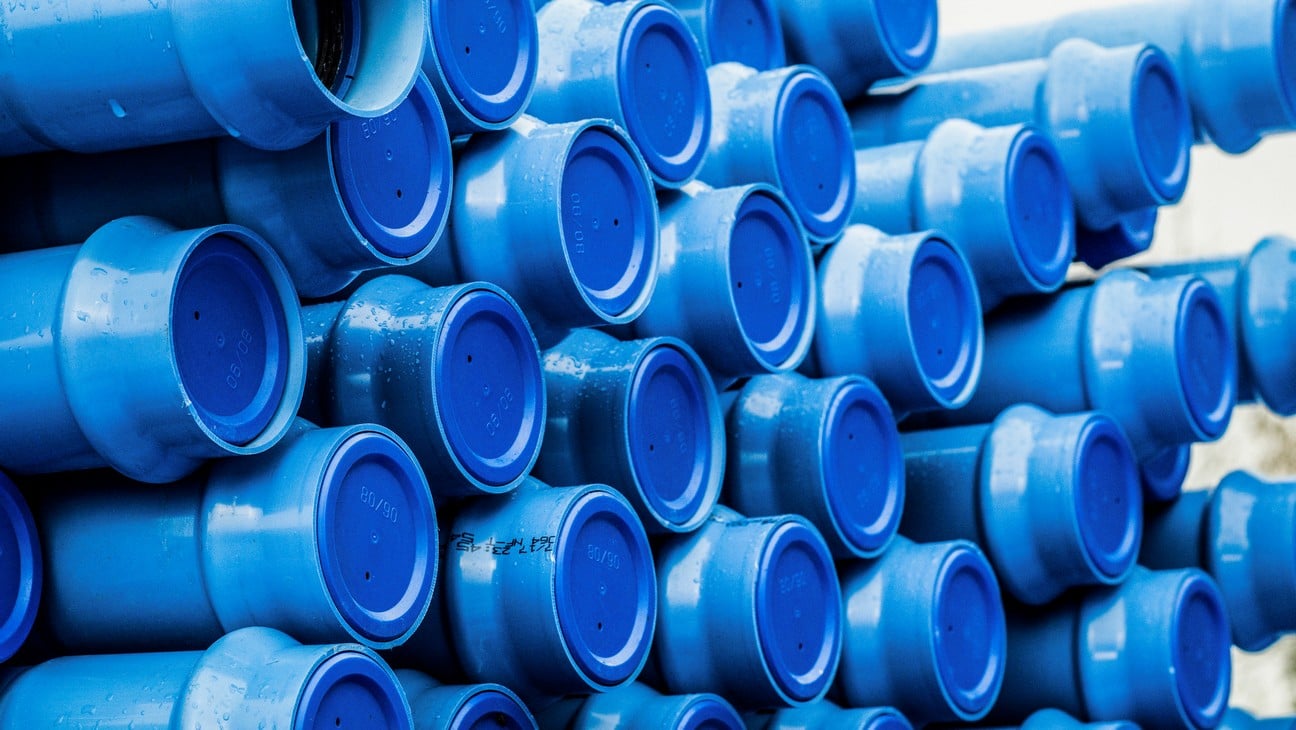

Features & benefits
- Molecor is thin walled yet 5 times stronger than PE. This has resulted in water companies using smaller pipes yet with greater hydraulic capacity = lighter and more cost effective
- On average 75% lighter than Ductile Iron and 50% lighter than PE = less requirement for heavy lifting equipment and less back injuries
- 225mm stick of PE weighs 79.8kgs. The equivalent capacity in MOPVC is a 200mm stick which weighs just 30kgs. The difference when compared with Ductile is even greater!
- Easy, simple push fit assembly = huge advantage in terms of installation in mtrs / hours. Ideal for piecing in, no EF or Butt Fusion joints & equipment
- Unbeatable impact resistance = no need to re-coat on site as with Ductile when damaged
- Completely corrosion resistant = no special protection or coating even in most contaminated ground
- Pipes available 90-800mm in bar ratings 12.5, 16, 20 & 25 = the best choice even in high pressure situations
- Increased hydraulic capacity = between 15-40% more hydraulic capacity than other pipe materials with same external dimensions
- Excellent response to water hammer / Maximum flexibility / Joints 100% Watertight
- Approved under regulation 31 of the Water Supply (Water Quality) Regulations 2000 (currently awaiting renewal)
TOM®: The best choice for the conveyance of fluid under pressure
TOM® PVC-O pipes are a product developed exclusively with the Molecor innovative technology that provides the highest Molecular Orientation. The manufacturing process is continuous and completely automatic, which ensures the maximum product reliability and a quality control tube to tube for the 100% of the production.
TOM® is the best solution for the conveyance of water at medium and high pressure for irrigation systems, drinking water supply, reuse, industrial or fire protection lines, among other uses. The extraordinary technical advances of the manufacturing system of Molecor confer the TOM® Oriented PVC pipe significant improvements:
Testimonials
“Shropshire & Powys water infra R&M working with the STW New Products Group have been successfully trialling a new type of lightweight pipe called Molecor PVC.
The pipe which has significant H&S benefits & cost savings for the business it has been used on several jobs, saving in the region of £1K each time in transportation costs of our usual heavier ductile iron pipe.
The benefits of Molecor PVC
- Improved mechanical aspects of the pipe
- Increased impact resistance
- Eliminates the risk of crack propagation
- Increased long-term service life
- Its resistance to internal pressure
- Improved water hammer properties
Steve – Team Manager who has been leading the trial said;
“Molecor is not like the normal PVC we are used to seeing on the network, its totally unique design and molecular construction means its a lot more hard wearing and less prone to strength reduction. The benefits are clear to see and the teams prefer to use it!””
Severn Trent Water – Jamie
“Potential benefits for United Utilities
• £21k/annum procurement saving by replacing relevant Amey Ductile Iron / HPE orders with Molecor
• A potential 33% procurement saving on other works
• Delivery eficiencies on repair & minor capital works
• Reduction in Lost Time Incidents and Injuries
• More reliable network – increased asset lifespans
• Reduced carbon footprint in operations”.
“All lay so far has been in carriage with lots of services in the way, but we have found we are now able to cold bend pipes around other services which is a major benefit over using fittings. The streets are often very narrow here so we are unable to use large trucks or stock material at the side of the road. As we have to double handle everything, one of the big benefits of Molecor is that due to its light weight we can load 8-10 pipes or more at a time at our compound onto our smaller transit truck which would have been impossible with Ductile due to the weight. This is then easy to offload once we get to site, usually in the street with minimal mechanical handling being required, vastly speeding up the whole process. Our operatives really like the pipe and just how easy it is to move around.
The cost of the pipe has contributed to a potentially significant saving and we eagerly await the arrival of an anchored system. This would mean Molecor could be the preferred option for many of our projects”.
“… the pipleline began at the very southern end of Poringland. This 1.8km section ran along the main road and had a high density of resident’s driveways along most of it. Following on from the feedback gained in the earlier section cross the field, it was decided that the ease of lay, the low weight and easy handling of MOPVC, would lend itself to this section. The 5.95mtrs pushfit pipes require no mechanical lifting equipment, no large transportation vehicles and no specialist jointing machinery. This also gave the engineers the freedom to excavate, lay and reinstate short sections, thus minimizing the disruption to residents…
MOPVC cold bends very well and gives circa 5.6 degrees of bend over a full length of 225mm… The ease of working with the pipe was noted throughout the project”.
“With regard to Molecor & MoPVC I am glad to provide some initial feedback:
As you know previously we were using MoPVC a few years back very successfully. The manufacturers at the time said they couldn’t make it cheap enough so reverted to only manufacturing PE… it was great news when you said that Molecor were in fact producing MoPVC with the new efficient manufacturing technique.
The scheme we are on at Cranbrook is going very well with Molecor. So far we have installed over 2000mtrs (160mm & 110mm) and the feedback from the gangs is extremely good; it is lightweight, needs no special equipment and so machinery is often not required and the previous issues with EF & Butt Fusion (jointing / cooling times) are non-existent with push fit pipe.
It’s too early to put an exact figure on the savings but we will before long, however, what I can tell you is that an average 160mm Butt Fusion joint takes anything between 25 & 35 mins per joint if all goes well. Not only is there no equipment to hire / off hire but on average we are taking under a minute to do each push fit joint with Molecor, as you would expect this time saving is beneficial to Kier, the developer and SWW, especially as we are normally the first in and the other utility providers are waiting to follow on from us.
From a H&S perspective the material is lightweight so this greatly reduces the usual manual handling, working with machinery issues for our operatives and with the increased speed of installation this means that they are spending less time in the excavations”.
